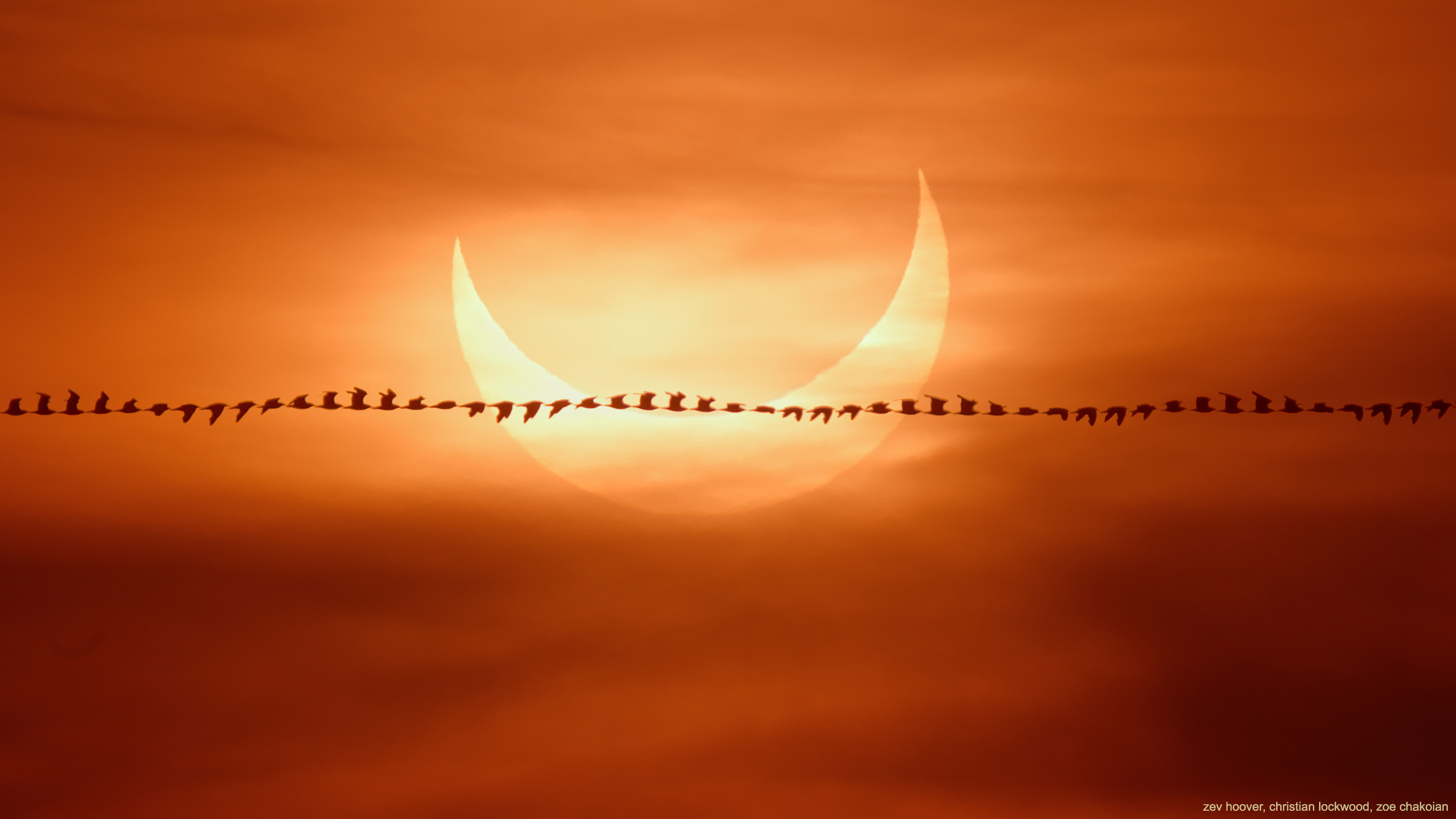11. June 2021
飛過日食

探索宇宙1!逐工會揀一幅無仝款 ê 影像抑是相片,𤆬你熟似咱這个迷人 ê 宇宙,閣有專業天文學者2為你3解說4。
- 原始文章:Eclipse Flyby
- 影像來源 kah 版權:Zev Hoover, Christian Lockwood, and Zoe Chakoian
- 投稿到 APOD ê 美麗相片:頂禮拜 ê 日食相片
- 台文翻譯:An-Li Tsai (NCU)
[漢羅] 飛過日食
Tī 6 月 10 號初一彼工,月球 ùi 太陽面頭前行過。 這工拄仔好是月球 經過遠地點 ê 兩工後,to̍h 是伊行到長株圓軌道上遠彼陣。 這工 ê 月球看起來有較細,才來產生這个金環日食。 這个金環日食雖然出現 ê 時間真短,毋閣足壯觀 ê。 你會當看著明亮 ê 太陽盤變做一个火環。 這是 ùi 迒過地球北方 ê 狹細烏影帶內底看著 ê 景色。 Tī 美國東岸透早 ê 天頂,會當看著 華麗 ê 日偏食。 日頭 kah 月娘同齊 peh--起來。 這張數位組合相片是 tī 食甚左右翕 ê 連紲影像,是 ùi 麻州 Boston 南爿 ê Quincy 海岸翕--ê。 這个意外翕著 ê 連紲影像 是日出彼陣,有一隻鳥仔飛過有月球剪影 ê 太陽產生 ê 波動路線。
[POJ] Poe-kòe Ji̍t-si̍t
Tī la̍k-goe̍h cha̍p-hō chhoe-it hit-kang, Goe̍h-kiû ùi Thài-iông bīn-thâu-chêng kiâⁿ-kòe. Chit-kang tú-á-hó sī Goe̍h-kiû kéng-kòe oán-tē-tiám ê nn̄g-kang āu, to̍h sī i kiâⁿ-kàu tn̂g-tu-îⁿ kúi-tō siōng hn̄g hit-chūn. Chit-kang ê Goe̍h-kiû khòaⁿ--khí-lâi ū khah sè, chiah-ē sán-seng chi̍t-ê kim-khoân ji̍t-si̍t. Chit-ê kim-khoân ji̍t-si̍t sui-jiân chhut-hiān ê sî-kan chin té, m̄-koh chiok chòng-koan ê. Lí ē-tàng khòaⁿ-tio̍h bêng-liōng ê Thài-iông-pôaⁿ piàn-chò chi̍t-ê hóe-khoân. Che sī ùi hāⁿ-kòe Tē-kiû pak-hong ê e̍h-sè o͘-iáⁿ lāi-té khòaⁿ-tio̍h ê kéng-sek. Tī Bí-kok tang-hōaⁿ thàu-chá ê thiⁿ-téng, ē-tàng khòaⁿ-tio̍h hôa-lē ê ji̍t-phian-si̍t. Ji̍t-thâu kah Goe̍h-niû tâng-chê peh--khí-lâi. Chit-tiuⁿ só͘-ūi cho͘-ha̍p siòng-phìⁿ sī tī si̍t-sīm chó-iū hip--ê liân-sòa iáⁿ-siōng, sī ùi Mâ-chiu Boston lâm-pêng ê Quincy hái-hōaⁿ hip--ê。 Chit-ê ì-gōa hip--tio̍h ê liân-sòa iáⁿ-siōng sī ji̍t-chhut hit-chūn, ū chi̍t-chiah chiáu-á poe-kòe ū Goe̍h-kiû chián-iáⁿ ê Thài-iông sán-seng ê pho-tōng lō͘-sòaⁿ.
[KIP] Pue-kuè Ji̍t-si̍t
Tī la̍k-gue̍h tsa̍p-hō tshue-it hit-kang, Gue̍h-kiû uì Thài-iông bīn-thâu-tsîng kiânn-kuè. Tsit-kang tú-á-hó sī Gue̍h-kiû kíng-kuè uán-tē-tiám ê nn̄g-kang āu, to̍h sī i kiânn-kàu tn̂g-tu-înn kuí-tō siōng hn̄g hit-tsūn. Tsit-kang ê Gue̍h-kiû khuànn--khí-lâi ū khah sè, tsiah-ē sán-sing tsi̍t-ê kim-khuân ji̍t-si̍t. Tsit-ê kim-khuân ji̍t-si̍t sui-jiân tshut-hiān ê sî-kan tsin té, m̄-koh tsiok tsòng-kuan ê. Lí ē-tàng khuànn-tio̍h bîng-liōng ê Thài-iông-puânn piàn-tsò tsi̍t-ê hué-khuân. Tse sī uì hānn-kuè Tē-kiû pak-hong ê e̍h-sè oo-iánn lāi-té khuànn-tio̍h ê kíng-sik. Tī Bí-kok tang-huānn thàu-tsá ê thinn-tíng, ē-tàng khuànn-tio̍h huâ-lē ê ji̍t-phian-si̍t. Ji̍t-thâu kah Gue̍h-niû tâng-tsê peh--khí-lâi. Tsit-tiunn sóo-uī tsoo-ha̍p siòng-phìnn sī tī si̍t-sīm tsó-iū hip--ê liân-suà iánn-siōng, sī uì Mâ-tsiu Boston lâm-pîng ê Quincy hái-huānn hip--ê。 Tsit-ê ì-guā hip--tio̍h ê liân-suà iánn-siōng sī ji̍t-tshut hit-tsūn, ū tsi̍t-tsiah tsiáu-á pue-kuè ū Gue̍h-kiû tsián-iánn ê Thài-iông sán-sing ê pho-tōng lōo-suànn.
[English] Eclipse Flyby
On June 10 a New Moon passed in front of the Sun. In silhouette only two days after reaching apogee, the most distant point in its elliptical orbit, the Moon's small apparent size helped create an annular solar eclipse. The brief but spectacular annular phase of the eclipse shows a bright solar disk as a ring of fire when viewed along its narrow, northerly shadow track across planet Earth. Cloudy early morning skies along the US east coast held gorgeous views of a partially eclipsed Sun though. Rising together Moon and Sun are captured in a sequence of consecutive frames near maximum eclipse in this digital composite, seen from Quincy Beach south of Boston, Massachusetts. The serendipitous sequence follows the undulating path of a bird in flight joining the Moon in silhouette with the rising Sun.
詞彙學習
| 漢羅 | POJ | KIP | 華語 | English |
|---|---|---|---|---|
| 金環日食 | kim-khoân ji̍t-si̍t | kim-khuân ji̍t-si̍t | 日環食 | annular eclipse |
| 日偏食 | ji̍t-phian-si̍t | ji̍t-phian-si̍t | 日偏食 | partial eclipse |
| 遠地點 | oán-tē-tiám | uán-tē-tiám | 遠地點 | apogee |
| 長株圓軌道 | tn̂g-tu-îⁿ kúi-tō | tn̂g-tu-înn kuí-tō | 橢圓形軌道 | elliptical orbit |
| 食甚 | si̍t-sīm | si̍t-sīm | 食甚 | maximum eclipse |